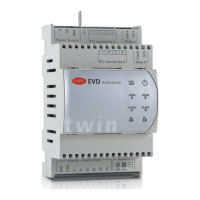ENG
“EVD Evolution TWIN” +0300006EN - rel. 2.6 - 31.01.2019
61
Parameter/Description Def. / UoM
CONFIGURATION
PROBES
S3: calibration gain 4 to 20 mA (CANNOT BE SELECTED) 1
CONTROL
Discharge superheat set point 35
Discharge temperature set point 105
SPECIAL
HiTcond: thresh.old 80
HiTcond: integral time 20
Modulating thermostat: set point 0
Modulating thermostat: dierential 0.1
Modulating thermostat: superheat set point oset 0
ALARM CONFIGURATION
High condensing temperature alarm delay (HiTcond) 600
Tab. 13.b
13.5 Programming with the display
Before setting the parameters, switch the display to driver A.
Important: ignore the parameters for driver B.
A
CONFIGURAZIONE
SONDA S1
Raziom., -1/9.3 barg
REGOLAZIONE PRINCIPALE
banco frigo/cella canalizzati
Fig. 13.c
13.6 Auxiliary refrigerant
In the event of cascade systems comprising a main circuit and a secondary
circuit, the auxiliary refrigerant is the refrigerant in the secondary circuit. See
the paragraphs “Auxiliary control” and “Reverse high condensing temperature
protection (HiTcond) on S3”. The default value 0 sets the same refrigerant as
in the main circuit.
Parameter/description Def.
Min Max U.M.
CONFIGURATION
Refrigerant:
-1= user dened; 0= same as main control;
1= R22 2= R134a 3= R404A
4= R407C 5= R410A 6= R507A
7= R290 8= R600 9= R600a
10= R717 11= R744 12= R728
13= R1270 14= R417A 15= R422D
16= R413A 17= R422A 18= R423A
19= R407A 20= R427A 21= R245FA
22= R407F
23=R32 24=HTR01
25= HTR02
26=R23 27 = R1234yf
28 = R1234ze 29 = R455A 30 = R170
31 = R442A 32 = R447A 33 = R448A
34 = R449A 35 = R450A 36 = R452A
37 = R508B 38 = R452B 39 = R513A
40 = R454B 41 = R458A
R404A - - -
Tab. 13.c
Note:
• for cascade CO2 systems, at the end of the commissioning procedure, also
set the auxiliary refrigerant. See the paragraph on reverse HiTcond;
• if the refrigerant is not among those available for the “Refrigerant”
parameter”:
1. set any refrigerant (e.g. R404);
2. select the model of valve, the pressure probe S1, the type of main
control and end the commissioning procedure;
3. enter programming mode and set the type of refrigerant: custom, and
the parameters “Dew a…f high/low” and “Bubble a…f high/low” that
dene the refrigerant;
4. start control, for example by closing the digital input contact to enable
operation.
13.7 S3 e S4 inputs
The auxiliary probe S3 is associated with the high condensing temperature
protection or can be used as a backup probe for the main probe S1. If the
probe being used is not included in the list, select any 0 to 5 V ratiometric or
electronic 4 to 20 mA probe and then manually modify the minimum and
maximum measurement in the manufacturer parameters corresponding to
the probes.
Important: probes S3 and S4 are shown as NOT USED if the “auxiliary
control” parameter is set as “disabled”. If “auxiliary control” has any other setting,
the manufacturer setting for the probe used will be shown, which can be
selected according to the type.
Priority of digital inputs
In certain cases the setting of digital inputs 1 and 2 may be the same or
alternatively may be incompatible (e.g.: digital input 1 = regulation backup,
digital input 2 = regulation security). The problem thus arises to determine
which function the driver needs to perform.
Consequently, each type of function is assigned a priority, primary (PRIM) or
secondary (SEC), as shown in the table:
DI1/DI2 conguration Type of function
1=Disabled SEC
2=Valve regulation optimization after defrost SEC
3=Discharged battery alarm management SEC
4=Valve forced open (at 100%) SEC
5=Regulation start/stop PRIM
6=Regulation backup PRIM
7=Regulation security PRIM
Tab. 13.d
There are four possible cases of digital input congurations with primary or
secondary functions.
Function set Function performed by digital input
DI1 DI2 PRIM SEC
PRIM PRIM DI1 -
PRIM SEC DI1 DI2
SEC PRIM DI2 DI1
SEC SEC Regulation backup
(supervisor variable)
DI1
Tab. 13.e
Note that:
• if digital inputs 1 and 2 are set to perform a PRIM function, only the function
set for input 1 is performed;
• if the digital inputs 1 and 2 are set to perform a SEC function, only the SEC
function set for input 1 is performed; the driver will be set to “Regulation
backup” with the value of the digital input determined by the “Regulation
backup from supervisor” variable.
13.8 Main control – additional functions
The following additional functions are available using probes S3 and S4.
BLDC Control with compressor
Important: this type of control is incompatible with adaptive control
and autotuning.
To be able to use this control function, only available for CAREL valve drivers,
the driver must be connected to a CAREL pCO programmable controller
running an application able to manage a unit with BLDC scroll compressor.
In addition, the compressor must be controlled by the CAREL Power+
“speed drive” (with inverter), specially designed to manage the speed prole
required by the compressor operating specications. Two probes are needed
for superheat control (PA, TA) plus two probes located downstream of the
compressor (PB, TB) for discharge superheat and discharge temperature (TB)
control.
Parameter/Description Def.
CONFIGURATION
Main control
…
AC/chiller with BLDC compressor
multiplexed showcase/cold
room
Tab. 13.f

